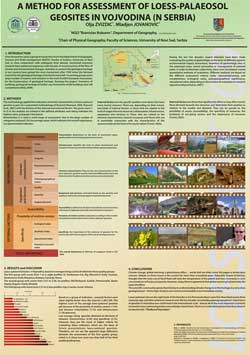LOESSFEST'09 | Aug. 31st – Sept. 3rd, 2009 |Novi Sad-Serbia
A Method for Assessment of Loess-Paleosol Geosites in Vojvodina (N. Serbia)
Zvizdić, O.1, Jovanović, M.1
1Department of Geography, Tourism and Hotel Managment, Faculty of Sciences, University of Novi Sad, Serbia
 During the last two decades several attempts have been made evaluating the
quality of geo-heritage on the basis of different aspects: environmental impact assessment,
inventory of geo-heritage sites in the protected areas, tourist promotion
or management of national parks. In order to eliminate subjectivity, there
were developed, mainly quantitative methods of evaluation. Different methods
are based on the different assessment criteria: rarity, representativeness, and completeness,
ecological value, paleogeographical significance, educational value, depending
on the content of evaluation or research objectives (Reynard et al., 2007).
The methodology applied for evaluation of certain characteristics of loess-paleosol
geo-sites is part of a customized methodology of Reynard (Reynard, 2006, Reynard
et al., 2007) with the division of the internal and external factors. The given
score (1 to 3) in the analysis are related to the defined attributes and rating 1indicates
the highest value, and grade 3 the lowest.
During the last two decades several attempts have been made evaluating the
quality of geo-heritage on the basis of different aspects: environmental impact assessment,
inventory of geo-heritage sites in the protected areas, tourist promotion
or management of national parks. In order to eliminate subjectivity, there
were developed, mainly quantitative methods of evaluation. Different methods
are based on the different assessment criteria: rarity, representativeness, and completeness,
ecological value, paleogeographical significance, educational value, depending
on the content of evaluation or research objectives (Reynard et al., 2007).
The methodology applied for evaluation of certain characteristics of loess-paleosol
geo-sites is part of a customized methodology of Reynard (Reynard, 2006, Reynard
et al., 2007) with the division of the internal and external factors. The given
score (1 to 3) in the analysis are related to the defined attributes and rating 1indicates
the highest value, and grade 3 the lowest.
Nevertheless it is used a small range of assessment, due to the large number of
categories analyzed (18) the average value, which indicates the overall importance,
is a representative indicator.
Internal factors are the specific qualities and values that have every tourist resource.
There are, depending on their nature, two kinds of internal factors: a)
those that are related to the level of usage of tourist resources (urbanization, infrastructure,
equipment and services) b) Those who are related to the inherent characteristics
(tourist) resources and those who are in essentially connection with the
characteristics of the resources that are the basis of its tourist values.
External factors are those that significantly affect or may affect tourist flows directed towards the resources and determine their position in relation to the market and demand. They can be parsed to: the possibility of access (accessibility), the specificity of resources, the proximity of out-going centers and the importance of resources.
On the basis of 18 categories analyzed, found that the best score, and the most important sections are: 1) Stari Slankamen - Čot, 1) Big Gully (1.33), 2) Feudvar, 2) Gully N-/St. Slankamen (1.39), 4) Batajnica (1.56), 5) Dukatar (1.61). Looking at the indicators, profiles have the best marks obtained in the vicinity of initial centers (1.44), the quality of transport infrastructure (1.58) and urbanization (1.67). Due to high application of criteria, characteristics such as paleogeographical and educational value, and representativeness of rarity have received relatively low marks (2.00 - 2.17). Total medium rating for all loess-paleosol geosites in Vojvodina is 1.95.
References:
- Reynard, E. (2006), http://www.unil.ch/igul/page17893.html.
- Reynard, E. et al. (2007), Geographica Helvetica, 62, 148-158



